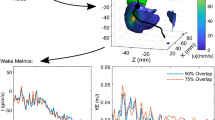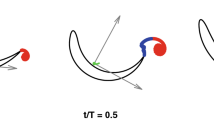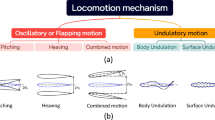Abstract
Engineers and biologists have long desired to compare propulsive performance for fishes and underwater vehicles of different sizes, shapes, and modes of propulsion. Ideally, such a comparison would be made on the basis of either propulsive efficiency, total power output or both. However, estimating the efficiency and power output of self-propelled bodies, and particularly fishes, is methodologically challenging because it requires an estimate of thrust. For such systems traveling at a constant velocity, thrust and drag are equal, and can rarely be separated on the basis of flow measured in the wake. This problem is demonstrated using flow fields from swimming American eels, Anguilla rostrata, measured using particle image velocimetry (PIV) and high-speed video. Eels balance thrust and drag quite evenly, resulting in virtually no wake momentum in the swimming (axial) direction. On average, their wakes resemble those of self-propelled jet propulsors, which have been studied extensively. Theoretical studies of such wakes may provide methods for the estimation of thrust separately from drag. These flow fields are compared with those measured in the wakes of rainbow trout, Oncorhynchus mykiss, and bluegill sunfish, Lepomis macrochirus. In contrast to eels, these fishes produce wakes with axial momentum. Although the net momentum flux must be zero on average, it is neither spatially nor temporally homogeneous; the heterogeneity may provide an alternative route for estimating thrust. This review shows examples of wakes and velocity profiles from the three fishes, indicating challenges in estimating efficiency and power output and suggesting several routes for further experiments. Because these estimates will be complicated, a much simpler method for comparing performance is outlined, using as a point of comparison the power lost producing the wake. This wake power, a component of the efficiency and total power, can be estimated in a straightforward way from the flow fields. Although it does not provide complete information about the performance, it can be used to place constraints on the relative efficiency and cost of transport for the fishes.







Similar content being viewed by others
References
Afanasyev YD (2004) Wakes behind towed and self-propelled bodies: asymptotic theory. Phys Fluids 16:3235–3238. doi:10.1063/1.1768071
Anderson EJ, McGillis WR, Grosenbaugh MA (2001) The boundary layer of swimming fish. J Exp Biol 204:81–102
Anderson JM (1996) Vortex control for efficient propulsion. Ph.D. Dissertation, Dept Ocean Eng, Mass Inst Tech
Batchelor GK (1973) An introduction to fluid dynamics. Cambridge University Press, Cambridge
Breder CM (1926) The locomotion of fishes. Zoologica 4:159–297
Dabiri JO (2005) On the estimation of swimming and flying forces from wake measurements. J Exp Biol 208:3519–3532. doi:10.1242/jeb.01813
Dabiri JO (2006) Note on the induced Lagrangian drift and added-mass of a vortex. J Fluid Mech 547:105–113. doi:10.1017/S0022112005007585
Drucker EG, Lauder GV (1999) Locomotor forces on a swimming fish: three-dimensional vortex wake dynamics quantified using digital particle image velocimetry. J Exp Biol 202:2393–2412
Drucker EG, Lauder GV (2001) Locomotor function of the dorsal fin in teleost fishes: experimental analysis of wake forces in sunfish. J Exp Biol 204:2943–2958
Finson ML (2006) Similarity behaviour of momentumless turbulent wakes. J Fluid Mech 71:465–479
Garland T (1998) Conceptual and methodological issues in testing the predictions of symmorphosis. In: Weibel ER, Taylor CR, Bolis L (eds) Principles of animal design. Cambridge University Press, Cambridge
Hartel KE, Halliwell DB, Launer AE (2002) Inland fishes of Massachusetts. Massachusetts Audobon Society, Lincoln, MA
Helfman GS, Collette BB, Facey DE (1997) The diversity of fishes. Blackwell Science, London
Kern S, Koumoutsakos P (2006) Simulations of optimized anguilliform swimming. J Exp Biol 209:4841–4857. doi:10.1242/jeb.02526
Kipling R (1907) Just so stories. Doubleday, Garden City, NY
Koochesfahani MM (1989) Vortical patterns in the wake of an oscillating airfoil. AIAA J 27:1200–1205
Krueger PS (2006) Measurement of propulsive power and evaluation of propulsive performance from the wake of a self-propelled vehicle. Bioinsp Biomimet 1:S49–S56. doi:10.1088/1748-3182/1/4/S07
Krueger PS, Gharib M (2003) The significance of vortex ring formation to the impulse and thrust of a starting jet. Phys Fluids 15:1271–1281. doi:10.1063/1.1564600
Lauder GV (2000) Function of the caudal fin during locomotion in fishes: kinematics, flow visualization, and evolutionary patterns. Am Zool 40:101–122
Lauder GV, Tytell ED (2006) Hydrodynamics of undulatory propulsion. In: Shadwick RE, Lauder GV (eds) Fish biomechanics. Academic, San Diego, pp 425–468
Lighthill J (1960) Note on the swimming of slender fish. J Fluid Mech 9:305–317
Lighthill J (1970) Aquatic animal propulsion of high hydromechanical efficiency. J Fluid Mech 44:265–301
Lighthill J (1971) Large-amplitude elongated-body theory of fish locomotion. Proc R Soc Lond B 179:125–138
McCutchen CW (1977) Froude propulsive efficiency of a small fish, measured by wake visualisation. In: Pedley TJ (ed) Scale effects in animal locomotion. Academic, London, pp 339–363
Meunier P, Spedding GR (2006) Stratified propeller wakes. J Fluid Mech 552:229–256. doi:10.1017/S0022112006008676
Müller UK, Smit J, Stamhuis EJ, Videler JJ (2001) How the body contributes to the wake in undulatory fish swimming: flow fields of a swimming eel (Anguilla anguilla). J Exp Biol 204:2751–2762
Müller UK, van den Heuvel B-LE, Stamhuis EJ, Videler JJ (1997) Fish foot prints: morphology and energetics of the wake behind a continuously swimming mullet (Chelon labrosus Risso). J Exp Biol 200:2893–2906
Naudascher E (1965) Flow in the wake of self-propelled bodies and related sources of turbulence. J Fluid Mech 22:625–656
Nauen JC, Lauder GV (2001) Locomotion in scombrid fishes: visualization of flow around the caudal peduncle and finlets of the chub mackerel Scomber japonicus. J Exp Biol 204:2251–2263
Nauen JC, Lauder GV (2002a) Hydrodynamics of caudal fin locomotion by chub mackerel, Scomber japonicus (Scombridae). J Exp Biol 205:1709–1724
Nauen JC, Lauder GV (2002b) Quantification of the wake of rainbow trout (Oncorhynchus mykiss) using three-dimensional stereoscopic digital particle image velocimetry. J Exp Biol 205:3271–3279
Prasad AK (2000) Stereoscopic particle image velocimetry. Exp Fluids 29:107–115
Prasad AK, Adrian RJ (1993) Stereoscopic particle image velocimetry. Exp Fluids 15:49–60
Rosén M, Spedding GR, Hedenstrom A (2004) The relationship between wingbeat kinematics and vortex wake of a thrush nightingale. J Exp Biol 207:4255–4268. doi:10.1242/jeb.01283
Rosen MW (1959) Waterflow about a swimming fish. US Naval Ordnance Test Station, China Lake, CA. Tech Publ 2298, pp 1–96
Schultz WW, Webb PW (2002) Power requirements of swimming: do new methods resolve old questions? Integr Comp Biol 42:1018–1025
Shames IH (1992) Mechanics of fluids, 3rd edn. McGraw-Hill, New York
Sirviente AI, Patel VC (2000) Wake of a self-propelled body, Part 1: momentumless wake. AIAA J 38:611–619
Spedding GR, Rayner JMV, Pennycuick CJ (1984) Momentum and energy in the wake of a pigeon (Columba livia) in slow flight. J Exp Biol 111:81–102
Standen EM, Hinch SG, Rand PS (2004) Influence of river speed on path selection by migrating adult sockeye salmon (Oncorhynchus nerka). Can J Fish Aquat Sci 61:905–912. doi:10.1139/F04-035
Standen EM, Lauder GV (2005) Dorsal and anal fin function in bluegill sunfish (Lepomis macrochirus): three-dimensional kinematics during propulsion and maneuvering. J Exp Biol 208:2753–2763. doi:10.1242/jeb.01706
Standen EM, Lauder GV (2007) Hydrodynamic function of dorsal and anal fins in brook trout (Salvelinus fontinalis). J Exp Biol 210:325–339. doi:10.1242/jeb.02661
Tennekes H, Lumley JL (1972) A first course in turbulence. MIT, Cambridge, MA
Triantafyllou GS, Triantafyllou MS, Grosenbaugh MA (1993) Optimal thrust development in oscillating foils with application to fish propulsion. J Fluids Struct 7:205–224
Tytell ED (2004a) The hydrodynamics of eel swimming. II. Effect of swimming speed. J Exp Biol 207:3265–3279. doi:10.1242/jeb.01139
Tytell ED (2004b) Kinematics and hydrodynamics of linear acceleration in eels, Anguilla rostrata. Proc R Soc Lond B 271:2535–2541. doi:10.1098/rspb.2004.2901
Tytell ED (2006) Median fin function in bluegill sunfish, Lepomis macrochirus: streamwise vortex structure during steady swimming. J Exp Biol 209:1516–1534. doi:10.1242/jeb.02154
Tytell ED, Ellington CP (2003) How to perform measurements in a hovering animal’s wake: physical modelling of the vortex wake of the hawkmoth Manduca sexta. Philos Trans R Soc Lond B 358:1559–1566. doi:10.1098/rstb.2003.1355
Tytell ED, Lauder GV (2004) The hydrodynamics of eel swimming. I. Wake structure. J Exp Biol 207:1825–1841. doi:10.1242/jeb.00968
van Ginneken V, Antonissen E, Müller UK, Booms R, Eding E, Verreth J, van den Thillart G (2005) Eel migration to the Sargasso: remarkably high swimming efficiency and low energy costs. J Exp Biol 208:1329—1335. doi:10.1242/jeb.01524
Walker JA (1998) Estimating velocities and accelerations of animal locomotion: a simulation experiment comparing numerical differentiation algorithms. J Exp Biol 201:981–995
Webb PW (1971) The swimming energetics of trout. I. Thrust and power output at cruising speeds. J Exp Biol 55:489–520
Webb PW (1992) Is the high cost of body caudal fin undulatory swimming due to increased friction drag or inertial recoil? J Exp Biol 162:157–166
Webb PW (2006) Stability and maneuverability. In: Shadwick RE, Lauder GV (eds) Fish biomechanics. Academic, San Diego, pp 281–332
Willert CE (1997) Stereoscopic digital particle image velocimetry for application in wind tunnel flows. Meas Sci Tech 8:1465–1479
Willert CE, Gharib M (1991) Digital particle image velocimetry. Exp Fluids 10:181–193
Zhu Q, Wolfgang MJ, Yue DKP, Triantafyllou MS (2002) Three-dimensional flow structures and vorticity control in fish-like swimming. J Fluid Mech 468:1–28
Acknowledgments
Many of the ideas in this review developed from a discussion with Rajat Mittal. Data were taken with funding from National Science Foundation grants to George V. Lauder (grant numbers IBN9807021 and IBN0316675). Support is currently provided by the National Institutes of Health (grant number 5 F32 NS054367).
Author information
Authors and Affiliations
Corresponding author
Rights and permissions
About this article
Cite this article
Tytell, E.D. Do trout swim better than eels? Challenges for estimating performance based on the wake of self-propelled bodies. Exp Fluids 43, 701–712 (2007). https://doi.org/10.1007/s00348-007-0343-x
Received:
Revised:
Accepted:
Published:
Issue Date:
DOI: https://doi.org/10.1007/s00348-007-0343-x




